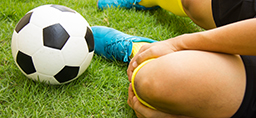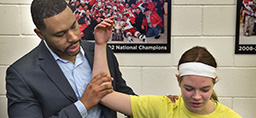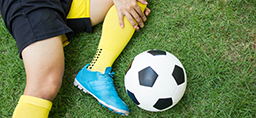
In June, during a Women’s World Cup semifinal, American player Morgan Brian and Germany’s Alexandra Popp both went up for a header and their heads collided.
Brian collapsed onto her stomach, kicking the turf in pain. Blood poured from beneath Popp’s blonde hair. Both suffered possible concussions.
While football dominates most of the headlines when it comes to summer and fall sports injuries, there are plenty of other sports-related ailments to be wary of—and plenty of ways to avoid the most damaging injuries.
“People are really focused on football with concussions, but girls soccer is the second highest sport for concussions,” said Jennifer Trpkovski, DO, who specializes in non-operative sports medicine at Spectrum Health Medical Group.
According to a recent study in The American Journal of Sports Medicine, which tracked concussions in high school athletics from 2008-10, women’s soccer had the second highest total number of concussions, accounting for 8.2 percent of all concussions. That trailed only American football (47.2 percent), and was ahead of high-contact sports like wrestling, basketball, hockey and others.
Dr. Trpkovksi said most concussions don’t come from bouncing a ball off your head—they come from plays like Brian and Popp’s World Cup incident, when players suffer head-to-head collisions.
Neck-strengthening exercises, proper heading techniques and coaches teaching players how to protect their bodies when going up for headers are key to avoiding concussions, she added.
In addition to concussions, other common injuries during the spring and fall seasons involve overuse of the arms in baseball and softball; knee and hip injuries in runners; and muscle pulls, ankle sprains and dehydration issues in a variety of sports.
The danger of one-sport athletes
Brandon Stolz, 17, a soon-to-be senior at Northview High School in Grand Rapids, has been playing year-round baseball for seven or eight years. He’s a pitcher for his high school team and he participates in summer travel leagues.
In early April, during a nine-day, baseball-related trip to Florida in which Stolz threw everyday, he started feeling pain in his elbow that continued until the end of the season in June. He took a month-long break on the advice of his doctor, but when he resumed throwing in mid-July the pain flared up again.
The injury was originally diagnosed as tendinitis from overuse, but he’s undergoing an MRI in the near future to make sure there is no structural damage. He and his family just want certainty.
“We’re tired of playing the guessing game,” he said.
Olusanjo Adeoye, MD, who specializes in orthopaedic sports medicine at Spectrum Health, said the rise of one-sport athletes has led to many of the overuse injuries that have plagued baseball in recent years.
“That was very unusual until five or 10 years ago,” Dr. Adeoye said. “The three-sports athlete was great and something to look up to, something to aspire to.
“Single-sport athletes are essentially doing the same repetitive motions year-round,” he said. “That lack of cross-training creates more issues in all joints.”
Dr. Adeoye recommends athletes participate in multiple sports to give specific joints and muscles lengthy breaks throughout the year.
Avoiding common injuries
The last major set of injuries in summer and fall sports involves muscle pulls, dehydration and biomechanical-imbalance problems. The latter occurs when a muscle becomes stronger or weaker than its opposing muscle, Dr. Trpkovski said.
When you have an injury in one area, other areas of the body compensate and take on added stress, which leads to more injuries in those areas.
You often see this with runners, Dr. Trpkovski said.
“Runners typically have tight hip flexors,” she said. “If they don’t stretch those, then their IT bands (in their knees) tighten up, and then their glutes shut down, and once you have that, you’re weaker.”
And then all it takes is one bad step.
“You could twist a knee where you otherwise wouldn’t,” she said, “and potentially tear a ligament or something of that nature.”
Dr. Trpkovski said proper stretching for hips, IT bands, quadriceps, hamstrings—before and after you run—can be the difference between maintaining healthy joints and muscles and suffering an injury.
If you do have an injury, she said, stop competing and stop exercising. If it continues, see a doctor. Rest leads to faster healing times, while continued use can exacerbate the problem.
 /a>
/a>
 /a>
/a>
 /a>
/a>